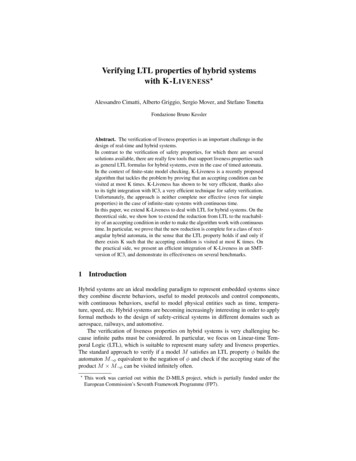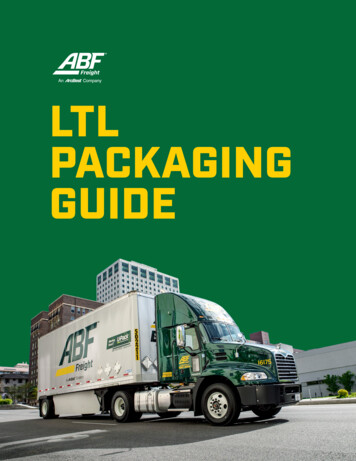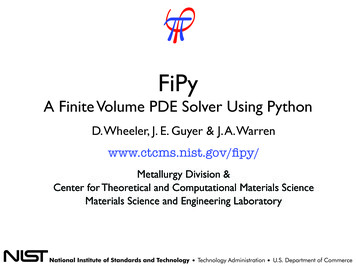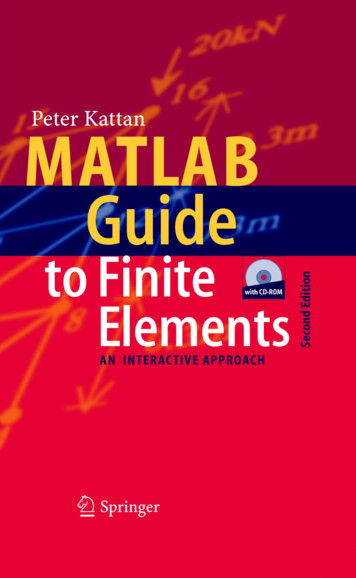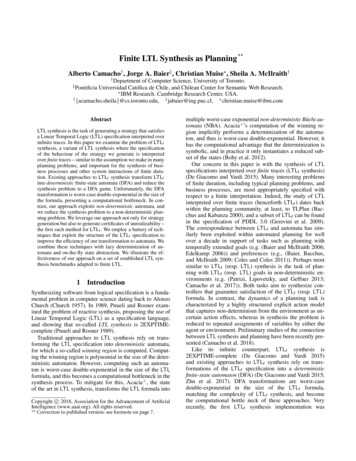
Transcription
Finite LTL Synthesis as Planning **Alberto Camacho† , Jorge A. Baier‡ , Christian Muise? , Sheila A. McIlraith†Department of Computer Science, University of Toronto.Pontificia Universidad Católica de Chile, and Chilean Center for Semantic Web Research.?IBM Research. Cambridge Research Center. USA.†{acamacho,sheila}@cs.toronto.edu, ‡ jabaier@ing.puc.cl, ? christian.muise@ibm.com†‡AbstractLTL synthesis is the task of generating a strategy that satisfiesa Linear Temporal Logic (LTL) specification interpreted overinfinite traces. In this paper we examine the problem of LTLfsynthesis, a variant of LTL synthesis where the specificationof the behaviour of the strategy we generate is interpretedover finite traces – similar to the assumption we make in manyplanning problems, and important for the synthesis of business processes and other system interactions of finite duration. Existing approaches to LTLf synthesis transform LTLfinto deterministic finite-state automata (DFA) and reduce thesynthesis problem to a DFA game. Unfortunately, the DFAtransformation is worst-case double-exponential in the size ofthe formula, presenting a computational bottleneck. In contrast, our approach exploits non-deterministic automata, andwe reduce the synthesis problem to a non-deterministic planning problem. We leverage our approach not only for strategygeneration but also to generate certificates of unrealizability –the first such method for LTLf . We employ a battery of techniques that exploit the structure of the LTLf specification toimprove the efficiency of our transformation to automata. Wecombine these techniques with lazy determinization of automata and on-the-fly state abstraction. We illustrate the effectiveness of our approach on a set of established LTL synthesis benchmarks adapted to finite LTL.1IntroductionSynthesizing software from logical specification is a fundamental problem in computer science dating back to AlonzoChurch (Church 1957). In 1989, Pnueli and Rosner examined the problem of reactive synthesis, proposing the use ofLinear Temporal Logic (LTL) as a specification language,and showing that so-called LTL synthesis is 2EXPTIMEcomplete (Pnueli and Rosner 1989).Traditional approaches to LTL synthesis rely on transforming the LTL specification into deterministic automata,for which a so-called winning region is computed. Computing the winning region is polynomial in the size of the deterministic automaton. However, computing such an automaton is worst-case double-exponential in the size of the LTLformula, and this becomes a computational bottleneck in thesynthesis process. To mitigate for this, Acacia , the stateof the art in LTL synthesis, transforms the LTL formula intoCopyright c 2018, Association for the Advancement of ArtificialIntelligence (www.aaai.org). All rights reserved.** Correction to published version: see footnote on page 7.multiple worst-case exponential non-deterministic Büchi automata (NBA). Acacia ’s computation of the winning region implicitly performs a determinization of the automaton, and thus is worst-case double-exponential. However, ithas the computational advantage that the determinization issymbolic, and in practice it only instantiates a reduced subset of the states (Bohy et al. 2012).Our concern in this paper is with the synthesis of LTLspecifications interpreted over finite traces (LTLf synthesis)(De Giacomo and Vardi 2015). Many interesting problemsof finite duration, including typical planning problems, andbusiness processes, are most appropriately specified withrespect to a finite interpretation. Indeed, the study of LTLinterpreted over finite traces (henceforth LTLf ) dates backwithin the planning community, at least, to TLPlan (Bacchus and Kabanza 2000), and a subset of LTLf can be foundin the specification of PDDL 3.0 (Gerevini et al. 2009).The correspondence between LTLf and automata has similarly been exploited within automated planning for wellover a decade in support of tasks such as planning withtemporally extended goals (e.g. (Baier and McIlraith 2006;Edelkamp 2006)) and preferences (e.g., (Baier, Bacchus,and McIlraith 2009; Coles and Coles 2011)). Perhaps mostsimilar to LTLf (resp. LTL) synthesis is the task of planning with LTLf (resp. LTL) goals in non-deterministic environments (e.g. (Patrizi, Lipovetzky, and Geffner 2013;Camacho et al. 2017)). Both tasks aim to synthesize controllers that guarantee satisfaction of the LTLf (resp. LTL)formula. In contrast, the dynamics of a planning task ischaracterized by a highly structured explicit action modelthat captures non-determinism from the environment as uncertain action effects, whereas in synthesis the problem isreduced to repeated assignments of variables by either theagent or environment. Preliminary studies of the connectionbetween LTL synthesis and planning have been recently presented (Camacho et al. 2018).Like its infinite counterpart, LTLf synthesis is2EXPTIME-complete (De Giacomo and Vardi 2015)and existing approaches to LTLf synthesis rely on transformations of the LTLf specification into a deterministicfinite-state automaton (DFA) (De Giacomo and Vardi 2015;Zhu et al. 2017). DFA transformations are worst-casedouble-exponential in the size of the LTLf formula,matching the complexity of LTLf synthesis, and becomethe computational bottle neck of these approaches. Veryrecently, the first LTLf synthesis implementation was
developed, Syft, which computes the winning region overa symbolic representation of the DFA rather than as anexplicit graph (Zhu et al. 2017).In this paper, we present the first LTLf synthesis systemthat not only computes strategies but that also produces certificates of unrealizability – a strategy and proof certificatethat will cause the the LTLf specification to be violated. Suchcertificates are very useful for incremental design and debugging, for verification, and as a tool for optimization. Incontrast to existing theory and to the only other LTLf realization we are aware of, our system relies on a transformationto NFA (rather than DFA). We then reduce LTLf synthesisto the task of finding a strong plan for a fully-observablenon-deterministic (FOND) planning problem. The FONDproblem captures the dynamics of non-deterministic finitestate automata (NFA) that corresponds to the original LTLfformula. Transformation of an LTL formula into an NFA isworst-case exponential in the size of the formula, and henceis computationally more appealing than a worst-case doubleexponential DFA transformation. The compilations in ourimplemented system employ a battery of techniques that allow planning algorithms to exploit structure, including symbolic automata decompositions of the specification, lazy determinization of the NFA, and on-the-fly state abstractions.The rest of the paper is organized as follows. We first review LTLf and its correspondence with automata, and introduce the FOND planning model (Section 2). We then givea formal definition of LTLf synthesis (Section 3) and definewhat stands for a certificate of unrealizability (Section 4).We exploit the duality between these two problems in a technique to determine realizability and unrealizability (Section5). We extablish a bidirectional mapping between LTLf synthesis and FOND planning (Section 6). The following sections describe the algoithmic details of our reductions fromLTLf realizability and unrealizability to FOND planning. Finally, we discuss the results of an empirical evaluation of ouralgorithms implemented in a tool that we called SynKit, andwe close with concluding remarks.22.1PreliminariesLinear Temporal LogicLinear Temporal Logic (LTL), first introduced by Pnueli(1977) as a specification language for reactive synthesis, is apropositional modal logic with modalities referring to time.LTLf has essentially the same syntax as LTL but is interpreted over finite traces. In particular, given a set of propositional symbols, P , LTLf formula ϕ is defined as follows:ϕ : p ϕ ϕ1 ϕ2 dϕ ϕ1 U ϕ2where p P , and d (next) and U (until) are temporal operators. Intuitively, the next specifies what needs to holdin the next time step, and the until specifies what needsto hold at least until something else holds. Other temporaloperators such as eventually ( ), always ( ), and release(R) are defined by the standard equivalences: ϕ U ϕ, ϕ ϕ, and ϕ1 R ϕ2 ( ϕ1 U ϕ2 ). LTLf also hasa weak-next operator ( t), defined by tϕ d ϕ, that tellsthat ϕ needs to hold in the next time step if such next timestep exists. Note that dϕ 6 d ϕ (De Giacomo and Vardi2013). Within the planning community, the study of LTL interpreted over finite traces dates back at least to the work byBacchus and Kabanza (1998) on specifying temporally extended goals, and was incorporated into PDDL 3.0 in 2006(Gerevini et al. 2009). Recent work uses LTLf (De Giacomoand Vardi 2013) as a specification language (e.g. (Camachoet al. 2017; De Giacomo et al. 2017)).LTLf formulae are interpreted over finite traces σ s0 · · · sn of propositional states, where each si is a set ofpropositions from P that are true in si . We say that σ satisfies an LTLf formula ϕ, denoted σ ϕ, when σ, 0 ϕ,where: σ, i p, for each p P { } iff si p. σ, i ϕ iff σ, i ϕ does not hold. σ, i ϕ1 ϕ2 iff σ, i ϕ1 and σ, i ϕ2 . σ, i dϕ iff i n and σ, (i 1) ϕ. σ, i ϕ1 U ϕ2 iff there exists a i j n such thatσ, j ϕ2 , and σ, k ϕ1 , for each i k j.The interpretation of other modal operators such as eventually and always follow from their definitions.2.2 LTLf and Finite State AutomataFor every LTLf formula ϕ, it is possible to construct a nondeterministic finite-state automaton (NFA), Aϕ , in worstcase exponential time, which accepts the models of ϕ(Baier and McIlraith 2006). Such an NFA is a tuple Aϕ hQ, Σ, q0 , δ, αi, where Q is a finite set of states, Σ containsall subsets of propositions in ϕ, q0 Q is the initial state,δ Q L(P ) Q is a transition relation, where L(P ) isthe set of propositional formulae over P , and α Q is a setof accepting states.A run of Aϕ on a word w x1 · · · xn Σ is a sequenceof states q0 q1 · · · qn such that (qi 1 , ϕi , qi ) δ and xi ϕifor each i {1, . . . , n}. A run is accepting if qn α. Ingeneral, more than one run of Aϕ may exist for an giveninput word. A word w is accepted when some run of A on wis accepting. The language of A is the set of words acceptedby A. Sometimes we slightly abuse notation and denote byδ(q, x) the set of states q 0 for which there is a formula ψ suchthat (q, ψ, q 0 ) δ and x ϕ.An NFA is, in particular, a deterministic finite-state automaton (DFA) when exactly one run exists for every inputstring. A DFA can be constructed (e.g. with the well-knownpowerset construction) by determinizing an NFA (Rabin andScott 1959).2.3FOND PlanningA FOND planning problem is a tuple P hF, I, G, Ai,where F is a finite set of propositional fluents; I F describes what holds in the initial state; G F describes whatmust hold in a state for the goal to be achieved; and A is afinite set of actions. We denote by Lits(F) : F { f f F} the set of literals of F. Planning states are sets ofliterals, and we say that a state s satisfies a literal f , denotedby s f , iff f s.
Each action a A is described by a set of preconditions (P rea ) and a set of effects (Eff a ). The preconditionsP rea Lits(F) describe what must hold in a state sfor a to be applicable. The outcome of a is selected nondeterministically from one of the effects in Eff a . Elementse in Eff a are sets of tuples ci ei . Each ei is a set of literals that describes the outcome s0 of a relative to state s andcondition ci . Each ci is a set of literals that describes the condition that must hold in a state s for ei to have effect. Whenno conditions exist, we simply write effects e Eff a as setsof literals. Formally, s0 f iff s f and f 6 e, or f e.Sometimes we abuse notation and write oneof (p, q) Eff ato denote that each effect in Eff a must be interpreted as twoeffects that contain, respectively, literals p and q.A policy is a mapping π from states to actions such that,if π(s) a, then a is applicable in s. A finite execution of π from state s0 is a finite sequence of state-actionss0 , a0 , s1 , a1 , . . . sn where each si 1 is an outcome of si byai . A finite execution of π achieves the goal G if sn f foreach f G.Different classes of solutions to FOND problems havebeen studied. In particular, strong solutions are policieswhose execution guarantees goal achievement in a finitenumber of steps, despite non-determinism. The class ofstrong cyclic solutions are policies π where the goal canbe achieved by π from each state that is reachable by πfrom the initial state. It has been shown that strong planningand strong cyclic planning are EXPTIME-complete problems (Rintanen 2004).3LTL-f Realizability and SynthesisThe problem of LTL synthesis was first introduced by Pnueliand Rosner (1989) to study the synthesis of a reactive module where the specification language used was LTL. Recently, De Giacomo and Vardi (2015) studied the synthesis problem for LTLf specifications (cf. Definition 1), anddetermined the problem to be 2EXPTIME-complete – andtherefore matching the complexity of LTL synthesis. In whatfollows, we denote by hX , Y, ϕi the LTLf synthesis problemwith specification ϕ over uncontrollable (resp. controllable)variables X (resp. Y).agent player to generate a state trajectory that is accepting with respect to the DFA (De Giacomo and Vardi 2015;Zhu et al. 2017). Solving a DFA game can be done in polynomial time in the size of the DFA. The computational bottle neck of these approaches has been the transformation ofthe specification into a DFA, which is worst-case doubleexponential in the size of the LTLf formula and matches thecomplexity of LTLf synthesis.LTLf synthesis can be reduced to LTL synthesis by translating the original LTLf specification formula ϕ into a largerLTL formula ϕ0 that contains extra variables and operators,and then solving the resulting LTL synthesis problem. Unfortunately, the resulting LTL formula ϕ0 is prohibitivelylarge, causing the resulting transformation to a corresponding Büchi automata to be impossible in practice. By comparison, transformation of the original LTLf formula, ϕ toa corresponding DFA is much easier to compute. Zhu et al.show that their state-of-the-art tool for LTLf synthesis, Syft,outperforms the approach of synthesis via reduction to LTLsynthesis.4LTL-f UnrealizabilityIn this section we define LTLf certificates of unrealizability,and establish the correspondence between LTLf realizabilityand the existence of unrealizability certificates.An LTLf synthesis problem is unrealizable when no winning strategy for the agent exists. Viewed another way,the problem is unrealizable when the environment, ratherthan the agent, has a winning strategy in a similar setting.Formally, hX , Y, ϕi is unrealizable when the environmenthas a strategy g : (2Y ) 2X such that, for any sequence {Yi }i 0 (2Y )ω , the infinite sequence (g( ) Y0 ), {g(Y0 · · · Yi ) Yi 1 }i 0 does not have a finite prefixthat satisfies ϕ. That is, g is such that every finite prefix of(g( ) Y0 ), {g(Y0 · · · Yi ) Yi 1 }i 0 satisfies ϕ. Here, wewrite g( ) X to denote the first move of the environment,which does not depend on any of the agent moves.Definition 2. A certificate of unrealizability for an LTLfspecification hX , Y, ϕi is a strategy g : (2Y ) 2X suchthat, for any sequence {Yi }i 0 (2Y )ω , the infinite sequence (g( ) Y0 ), {g(Y0 · · · Yi ) Yi 1 }i 0 does not havea finite prefix that satisfies ϕ.Definition 1 (LTLf realizability and synthesis). Given twodisjoint sets of variables, X and Y, the realizability problemfor an LTLf specification hX , Y, ϕi is to determine whetherthere exists a strategy f : (2X ) 2Y such that, for eachinfinite sequence {Xi }i 0 (2X )ω of subsets of X , the sequence {Xi f (X0 · · · Xi )}i 0 has a finite prefix that satisfies ϕ. In this case, f is said to be a winning strategy. Thesynthesis problem for a realizable LTLf specification is tocompute a winning strategy. When hX , Y, ϕi is not realizable, we say that it is unrealizable.The function g is a certificate of unrealizability, as itproves that the environment has a strategy to prevent theagent from realizing ϕ. Theorem 1 characterizes the existence of certificates of unrealizability for an LTLf specification in terms of existence of winning strategies, and followsdirectly from Definitions 1 and 2.As noted briefly in the Section 1, existing approaches toLTLf synthesis rely on transformation of the LTLf specification into a DFA. These approaches then reduce the problem to finding a solution to a so-called DFA game wherethe agent player controls the X variables, the environmentplayer controls the Y variables, and the objective is for theExisting tools for LTLf realizability and synthesis do notprovide a certificate or explanation as to why a problem cannot be solved. Having such a certificate can be crucial tounderstanding or debugging errors in the modeling of theLTLf problem, and allows for independent verification thatthe problem has no solution. A certificate is an importantTheorem 1. An LTLf specification hX , Y, ϕi is realizableiff no certificate of unrealizability for hX , Y, ϕi exists.
tool in the arsenal of those who design and verify specifications and has a myriad of different applications in businessprocess design and modeling.5ApproachGiven an LTLf specification hX , Y, ϕi, our approach to LTLfsynthesis and unrealizability comprises four steps:(1) Preprocess hX , Y, ϕi to eliminate variables from X andY that do not appear in LTLf formula, ϕ.(2) Transform ϕ into NFA.(3) Encode X , Y together with the NFA states and dynamicsfrom (2) as a FOND planning problem instance.(4) Find a solution to the FOND problem constructed in (3).The following sections describe the algorithmic details ofa complete mapping from LTLf synthesis to strong planning(Section 7), and from LTLf unrealizability to strong cyclicplanning (Section 8).Solving LTLf Realizability and Unrealizability The duality between LTLf synthesis and the existence of certificatesof unrealizability (Theorem 1) can be exploited to determinewhether an specification is realizable or otherwise unrealizable. Corollaries 1 and 2 formalize these conditions. Assuch, realizability and unrealizability of a given LTLf specification can be determined by running two complete solversfor LTLf synthesis and unrealizability certificates computation, respectively.Corollary 1. An LTLf specification hX , Y, ϕi is realizablewhen either hX , Y, ϕi has a winning strategy, or no certificates of unrealizability for hX , Y, ϕi exists.Corollary 2. An LTLf specification hX , Y, ϕi is unrealizable when either hX , Y, ϕi has a certificate of unrealizability, or no winning strategy for hX , Y, ϕi exists.6LTL-f Synthesis and PlanningOur objective in this section is to establish a clear mappingbetween LTLf synthesis and FOND planning, two modelsfor sequential decision-making. Other attempts to map synthesis and planning have been done to cast FOND planningas a reactive synthesis task (e.g. (Sardiña and D’Ippolito2015)). The focus of this paper is in the other direction.6.1FOND Planning as LTL-f SynthesisThis section describes a polynomial reduction of a FONDproblem P hF, I, G, Ai into an LTLf synthesis problemhX P , Y P , ϕP i. Inspired by encodings of planning into SAT(Rintanen, Heljanko, and Niemelä 2006), our reduction generates a single LTLf formula ϕP : ϕinit ϕenv (ϕagt ϕg ), where ϕinit models the initial state I, ϕenvand ϕagt model the dynamics of P, and ϕg models the goalG.For each fluent f F and each action a A we create avariable in YP . XP is defined as {x0 , . . . , xM }, where M blog(maxa A Eff a )c. An assignment σ to all variables inPMXP can be seen as encoding the number i 0 2i [σ(xi ) true]; intuitively, once an action is executed by the agent,this number is used to encode which of its effects triggers.Below, we denote as Γk the formula of variables in XP thatencodes number k.Now we describe each part of ϕP . Formula ϕagt , whichmodels the agent’s action choice is a conjunction of twoformulae that must hold globally. The first formula models the action preconditions and correspondsto the conjuncVtion of formulae of the form (a P rea ), for everya A. The second formula establishes that exactlyW one actionisperformedatanytime,byconjoininga A a, andV0(a a).a,a0 A,a6 a0Formula ϕenv describes how the environment reacts to theexecution of actions. Assuming that Eff a {e0 , . . . , en },formula χa defines the successor state, which depends on thesetting of the Y variables by the environment. Intuitively, ifthe environment made Γk true, then the k-th effect of a triggers. The last effect en triggers if none of the the precedVn 1ing effects triggers. Formally χa ( i 0 Γi ) ( df Vn 1φf,en ) i 0 (Γi ( df φf,ei )), where φf,e is a propositional formula that encodes all conditions under which fis true in the next state after outcome e of action a occurs.Finally, ϕenv conjoins formulae (a t χa ) for eachVaction a A, ϕinit : I l l is the conjunction of theliterals in the initial state I, and ϕg : G.Theorem 2. A FOND problem P hF, I, G, Ai has astrong solution iff hX P , Y P , ϕP i is realizable.Proof sketch. The construction is such that, if hX P , Y P , ϕP iis realizable, then a winning strategy defines a policy that isa strong solution for P. In the other direction, a winningstrategy for the agent can be constructed from unfolding astrong policy for the FOND problem. Theorem 3. FOND strong planning can be reduced to LTLfsynthesis in polynomial time6.2LTL-f Synthesis as FOND PlanningIn this section we show a reduction of LTLf synthesisinto FOND planning. The reduction of an LTLf specification ϕ constructs a FOND planning problem Pϕ hF, I, G, Ai that simulates the dynamics of the 2-playergame between the environment and the agent over an NFAAϕ hQ, Σ, q0 , δ, αi that accepts the models of ϕ. The construction of Aϕ is worst-case exponential, and the components of Pϕ are polynomial in the size of Aϕ . Hence, thereduction is exponential.The components of Pϕ are defined as follows. The setof fluents is F : X Q {env, agt, goal}. The initial state I : {env, q0 } sets the turn to the environmentplayer, and the initial state of the automaton. Since the environment moves are uncontrollable to the agent, these aresimulated with a non-deterministic action aenv with precondition{env} and non-deterministic outcomes Eff aenv {agt, env} X X 2X . The moves of the agentplayer are controllable, and are thus simulated with deterministic actions in the set Aagt aZ Z 2X 2Y .Action aZ , where Z (X, Y ) simulates the agent playing Y after the environment has played X. The preconditionof aZ is {agt} X. The effects of aZ update the automaton configuration according to δ and the input X Y , and
reestablish the turn of the environment using conditional effects. Specifically, a(X,Y ) has conditional effect q q 0 forevery q, q 0 such that δ(q, X Y ) q 0 , it has conditionaleffect q goal for every q Q such that δ(q, X Y ) is afinal state, it has conditional effect q q for every q Q,and finally it has unconditional effects that remove agt andadd env. The set of planning actions is A : {aenv } Aagt .Finally, the goal condition is G {goal}.The actions of plans in the compiled FOND problem alternate aenv with an action in Aagt . Execution of an actionsequence aenv , aZ0 , . . . , aZm simulates played turns w (X0 Y0 ) · · · (Xm Ym ), and yields a state sm that entailssome automaton configuration Qm 2Q . The dynamics ofthe compiled FOND problem enforces the following property: q Qm iff there exists a run of Aϕ on w that finishesin q. In other words, Qm captures all the runs of the automaton. As such, the goal condition goal is reached when thesimulated play satisfies ϕ.A winning strategy for hX , Y, ϕi can be constructed froma strong policy π that solves Pϕ . Intuitively, f (X0 · · · Xn )is obtained by unfolding π in Pϕ , and selecting the environment action effects that follows the sequence X0 · · · Xn .Such strategy can be implemented compactly as a finite-statecontroller (FSC).Theorem 4. An LTLf synthesis problem hX , Y, ϕi is realizable iff the FOND problem Pϕ has a strong solution.Theorem 5. LTLf synthesis can be reduced into strongFOND planning in worst-case exponential time.7LTL-f Synthesis via PlanningIn Section 6 we established a mapping between LTLf synthesis and FOND planning. In this section we describe the algorithmic details of a reduction from LTLf synthesis to FONDplanning, corresponding to step number (3) in our approachdescribed in Section 5. In contrast to the mappings describedin Section 6, we focus on performance and introduce a number of effective techniques to exploit structure. We use aSTRIPS-like propositional language that can be adapted foruse with standard FOND planners that use PDDL or SAS description model languages (e.g. myND (Mattmüller et al.2010), PRP (Muise, McIlraith, and Beck 2012)). If desirable,more compact compilations can be easily obtained by usingnumeric fluents and conditional effects.We assume that an NFA Aϕ hQ, Σ, q0 , δ, αi for LTLfspecification formula ϕ is given, and construct a FOND0problem Pϕ hF, I, G, Ai. Below, for each pairV q, q Q,guard(q, q 0 ) is a DNF formula equivalent to (q,ψ,q0 ) δ ψ.The set T of transitions is defined as {(q, guard(q, q 0 ), q 0 ) q, q 0 Q}. We denote by macro(t), for t (q, ψ, q 0 ), theset of transitions in T of the form (q, ψ 0 , q 0 ).The dynamics of Pϕ simulates the two-player game between the environment and agent players. Each round is simulated with three consecutive stages. The first stage simulates, non-deterministically, the move of the environment.The second stage simulates the move of the agent. The thirdmode synchronizes the states of the automaton by performing those in accordance with the input move being simulated.F : {autState(q)}q Q {poss(t)}t T {sync} isTurn(v X ) {isTurn(v)}v X FactsFacts : {isAcc(t)}t.dest αI : {sync, autState(q0 )}A : {continue} {playX(v)}v X {transAcc(t), transRej(t)}t T {startSync} {syncAutState(q)}q QG : {winning}P replayX(vi ) : {isTurn(vi )}Eff playX(vi ) : {isTurn(vi 1 ), isTurn(vi )} oneof (e1 , e2 )e1 : { poss(t)} vi Lits(guard(t))e2 : { poss(t)}vi Lits(guard(t)) P retransAcc(t) : isTurn(v X ), poss(t), isAcc(t) Eff transAcc(t) : autState(q0 ), poss(t), winning poss(t0 ) t0 mutex(t) macro(t) P retransRej(t) : isTurn(v X ), poss(t), isAcc(t) Eff transRej(t) : autState(q0 ), poss(t) poss(t0 ) t0 mutex(t) macro(t) P restartSync : isTurn(v X ) Eff startSync : sync, isTurn(v X ) { poss(t)}t TP resyncAutState(q) : {sync, autState(q)}Eff syncAutState(q) : {poss(t)}t T,t.orig qP recontinue { autState(q)}: {sync} { autState(q)}q QEff continue : {isTurn(v0 ), sync}Figure 1: FOND compilation Pϕ : hF, I, G, Ai for anLTLf synthesis problem hX , Y, ϕi and given NFA Aϕ .In the first stage, the move of the environment is simulated with a cascade of actions playX(vi ) for each uncontrollable variable vi X , indexed for 0 i X . Theseactions have non-deterministic effects that simulate an uncontrollable assignment to variables in X . For convenience,we include an auxiliary fluent v X .In the second mode, the assignment to variables inY is simulated implicitly by means of transition actionstransAcc(t) and transRej(t), one for each t T . Intuitively, the agent decides which automaton transitions perform within the ones that are feasible. Then, the dynamicsof the problem simulates the assignment to variables Y necessary to satisfy guard(t), and deems unfeasible all transitions t0 whose guard is mutually exclusive with such assignment. Feasible transitions t T are identified by the
truth of fluents poss(t). More formally, transAcc(t) (resp.transRej(t)) sets poss(t0 ) false to all t0 mutex(t),where t0 mutex(t) if guard(t) guard(t0 ) . Forconvenience, transition actions can deem unfeasible all transitions t0 macro(t), as it can be proved that transAcc(t0 )and transRej(t0 ) are no longer relevant actions. Transitionactions for t (q, ψ, q 0 ) T turn the fluent autState(q0 )true to acknowledge that there exists a run of Aϕ on the wordw being simulated that finishes in q 0 . When q 0 is an acceptingstate (indicated by t.dest α), action transAcc(t) turnsthe fluent winning true to acknowledge that w is accepting.The third mode starts with the action startSync. In thethird stage, actions syncAutState(q) synchronize the automaton states, and deem feasible all transitions t T thathave origin state q (indicated by t.orig q). At the end ofthe third stage, action continue initiates the simulation of anew round by reestablishing the dynamics to the first stage.To conclude the description of Pϕ , the initial state I startsin synchronization mode, with the initial automaton state fluent autState(q0 ) set true. The goal condition is to set thefluent winning true.Theorem 6 states the correctness of the compilation. Astrategy f : (2X ) 2Y that realizes ϕ can be constructedfrom a strong solution to Pϕ by unfolding the policy over thesimulated turns of the two-player game. This can be implemented compactly in form of a finite-state controller (FSC).Because FOND is EXPTIME-complete (Rintanen 2004) andour translation is exponential in the size of the formula, theoverall approach is worst-case 2-EXPTIME in the size of ϕ.This is because the size of the compilation is worst-case exponential in the size of Aϕ , and therefore worst-case doubleexponential in the s
2.1 Linear Temporal Logic Linear Temporal Logic (LTL), first introduced by Pnueli (1977) as a specification language for reactive synthesis, is a propositional modal logic with modalities referring to time. LTL f has essentially the same syntax as LTL but is inter-preted over finite traces. In particular, given a set of propo-sitional .

